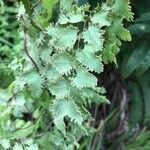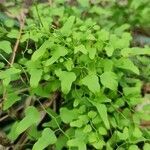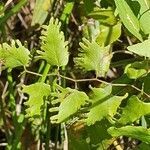Rhizome subterranean, 3 mm in diameter, producing fronds 40-130 mm apart; hairs on rhizome c. 1.5 mm long. Fronds up to 10 x 0.30 m, twining, matt grey-green, up to 2 mm in diameter, producing secondary rhachises; aborted apical bud densely dotted with brown multicellular hairs 1-4 mm long; sterile pinnules petiolate, lanceolate to oblong-lanceolate, up to 62 x 18 mm, base cordate, apex acute to acuminate, glabrous, margin minutely crenate,-veins free; fertile pinnules broadly lanceolate to oblong, 15-45 x 10-18 mm (excluding fertile lobes), base cordate, apex acute to rounded, glabrous, margin minutely crenate with fertile linear lobes up to 8 x 1 mm, produced at irregular intervals, bearing up to 25 sporangia in 2 rows.
Stems creeping. Leaves to ca. 10 m. Petioles borne 2-5 mm apart, 7-25 cm. Sterile pinnae on 0.5-1.5 cm stalks, oblong, 1-pinnate, 5-12 × 3-6 cm; ultimate segments triangular-lanceolate to oblong-lanceolate, truncate to shallowly cordate or somewhat auriculate proximally, usually not lobed, but if lobed, lobes rounded at apex and not directed toward leaf apex; segment apex rounded-acute to obtuse; segments articulate to petiolules, leaving wiry stalks when detached; blade tissue glabrous abaxially. Fertile pinnae on 0.5-1 cm stalks, oblong, 1-pinnate, 3-14 × 2.5-6 cm; ultimate segments ovate to lanceolate-oblong, fringed with fertile lobes, otherwise similar to sterile segments.
Rhizome long-creeping. Juvenile fronds once-forked; pinnae 4-lobed; margins crenate. Rachis subterete, flattened to slightly depressed on 1 side with ridged edges, glabrous or sparsely pubescent; primary rachis branches 2–5.5 mm long; secondary pinnae oblong, 1-pinnate, rarely 2-pinnate at base, 4–20 cm long, 2.5–10 cm wide; pinnule stalks of similar length to pinna apex; ultimate pinnules 2–5 cm long, 8–25 mm wide, membranous; laminal portion deciduous, ovate to lanceolate; base truncate to cuneate; margins finely or often obscurely crenulate; veins free; sterile pinnules usually longer than sporogenous ones. Sporogenous lobes 1.5–8 mm long.
A climbing fern which keeps growing from year to year. It grows 1-3 m long and spreads 30-90 cm wide. It has slender twining stems. The leaf is the climbing part. The stalk branches and produces 6-10 small fronds. The leaves are smooth fronds. They are divided into leaflets along the stalk. The leaflets are light green with short stalks. The leaflets are 6 cm long. The edges have fine teeth. The spores are produced on fertile leaflets which are smaller than the others. These ones have lobes on the edge. The slender, horizontal, underground stems are fleshy and brittle.




